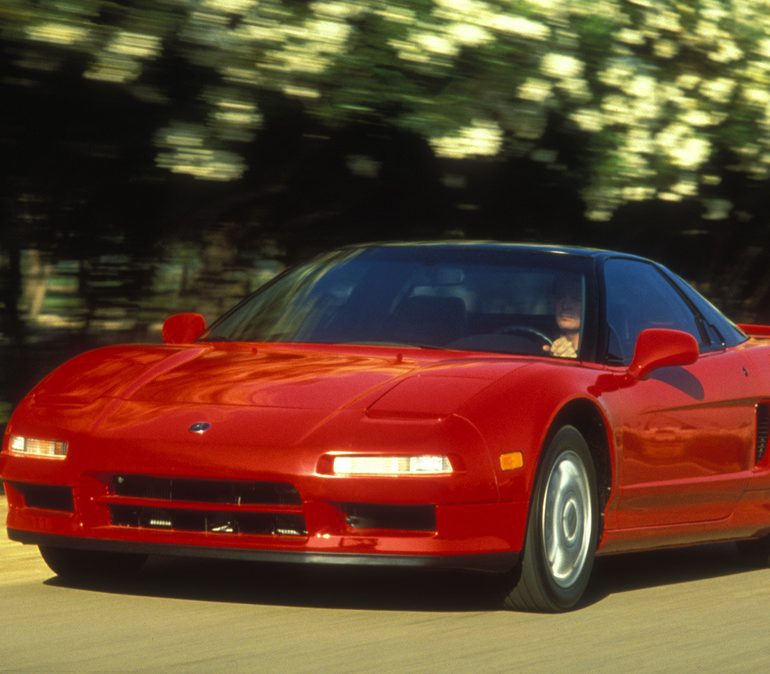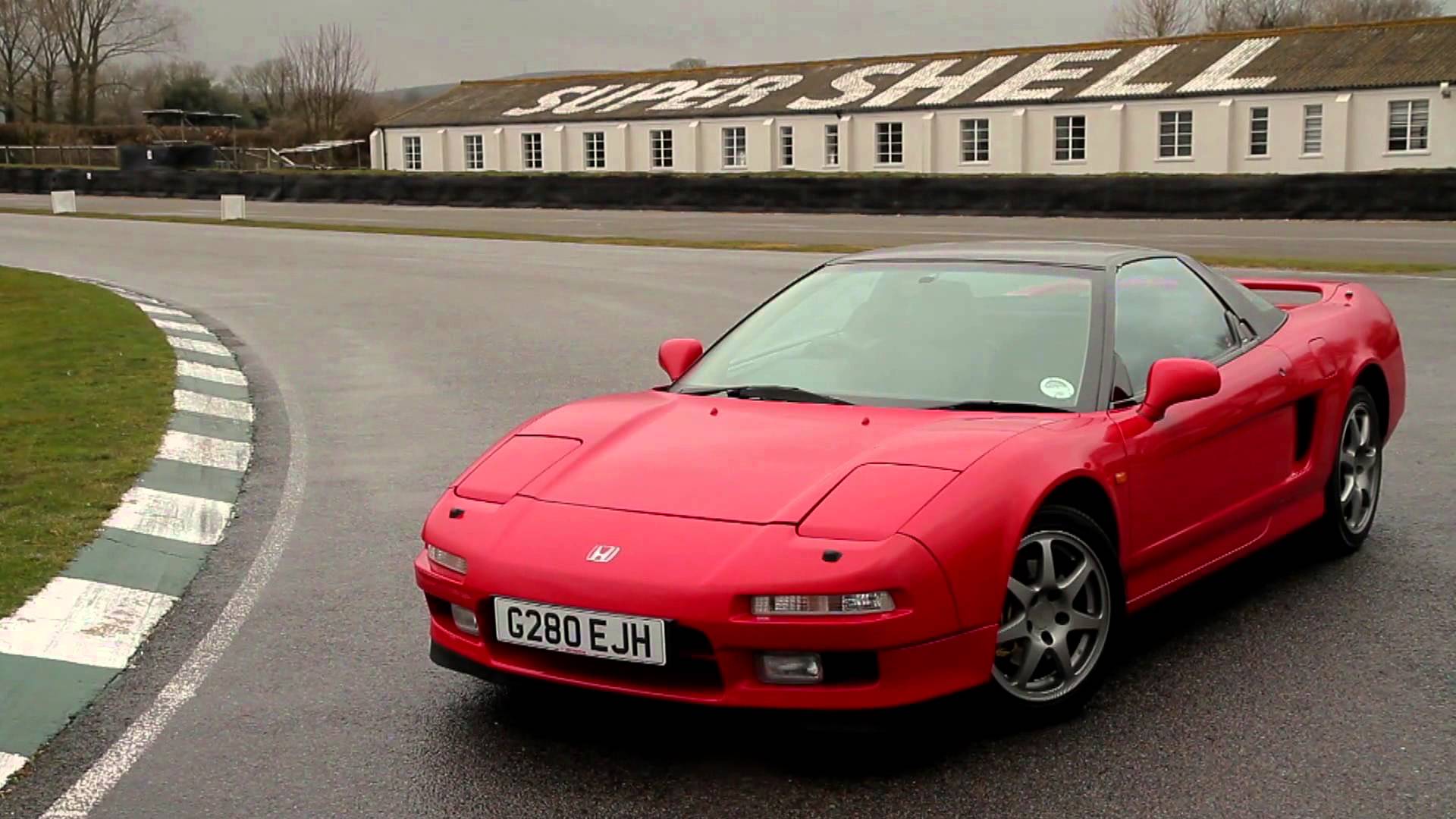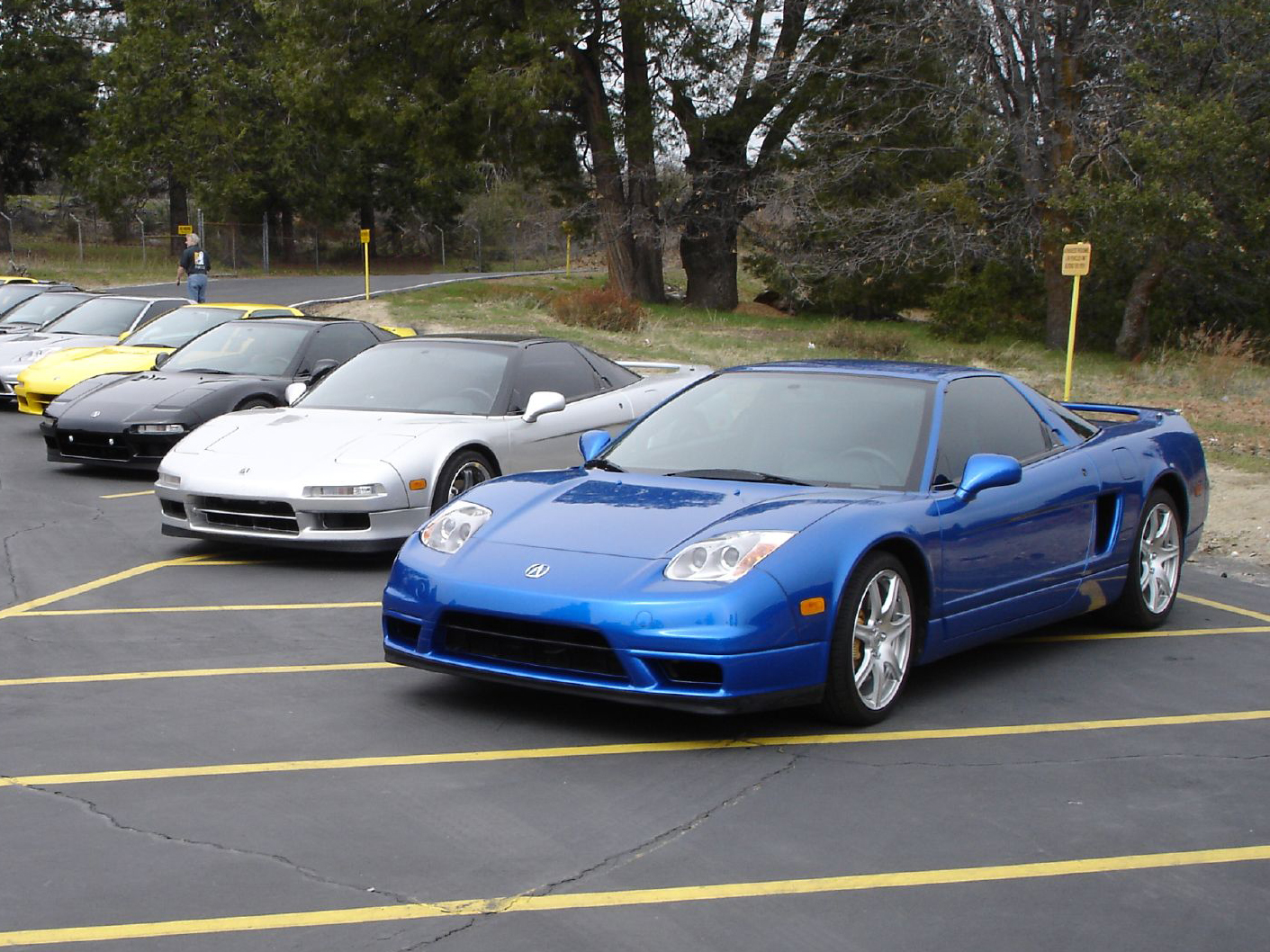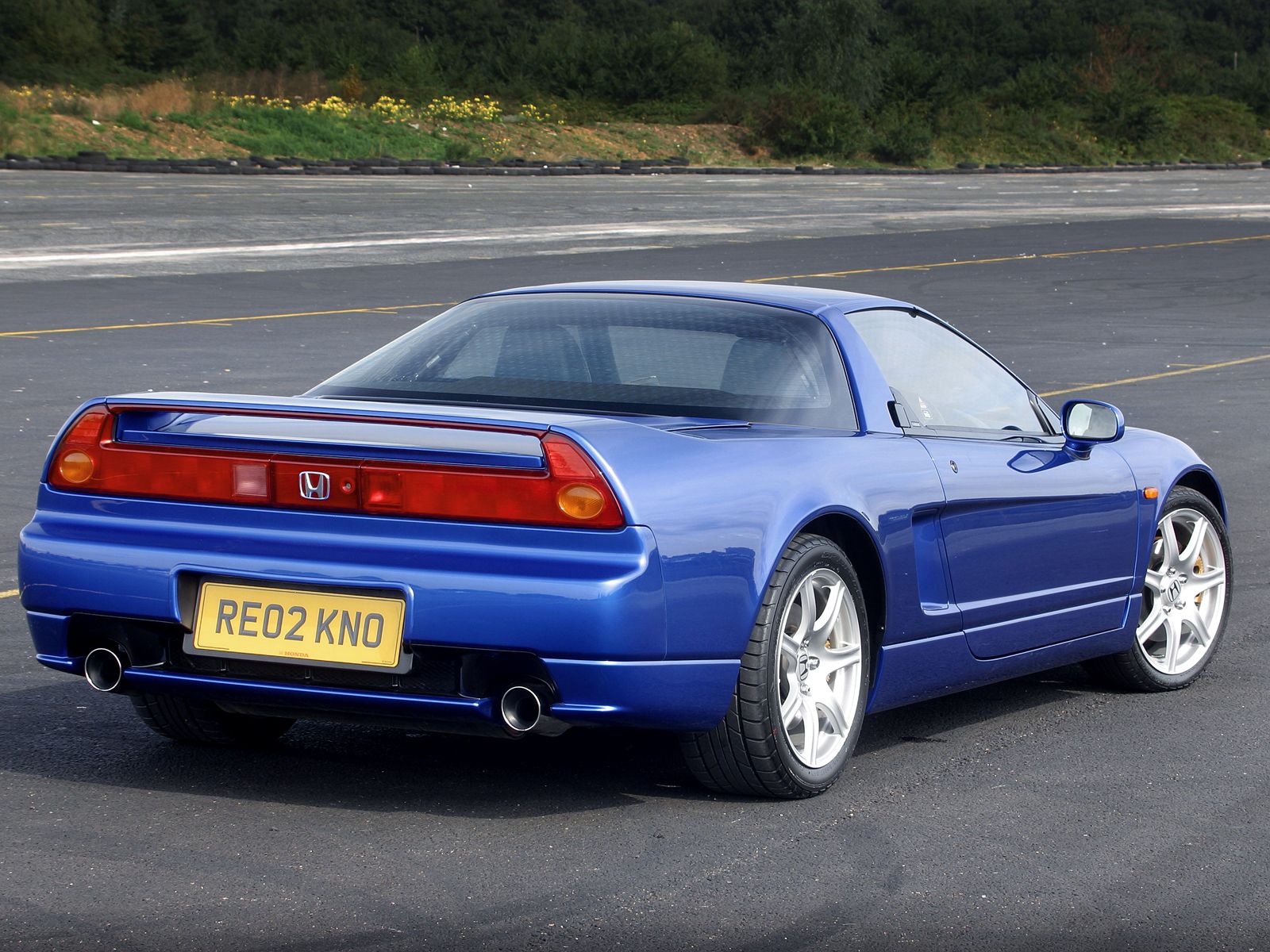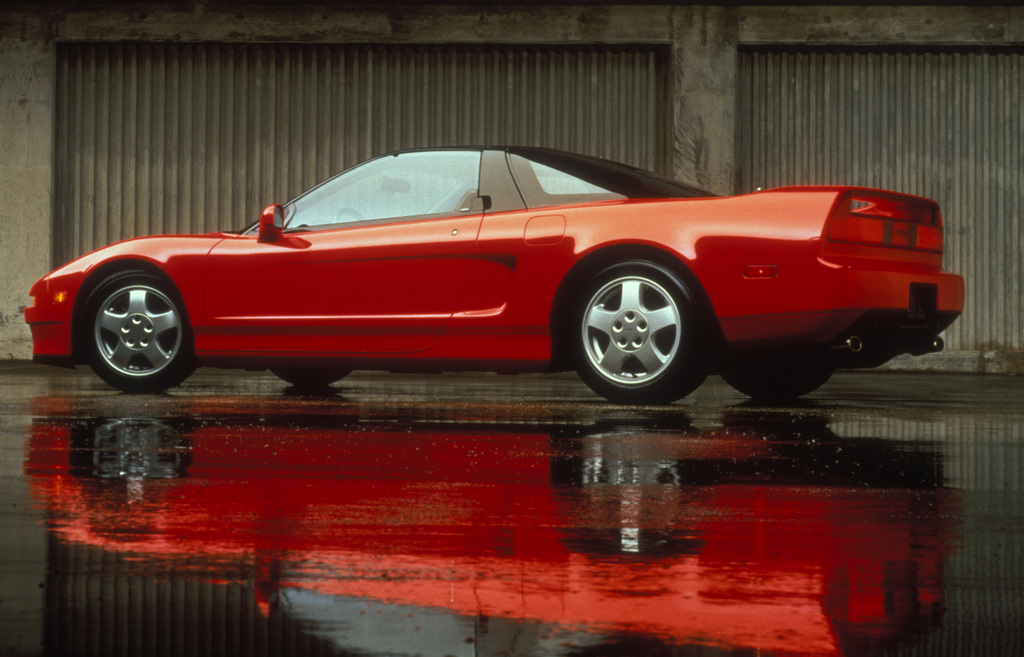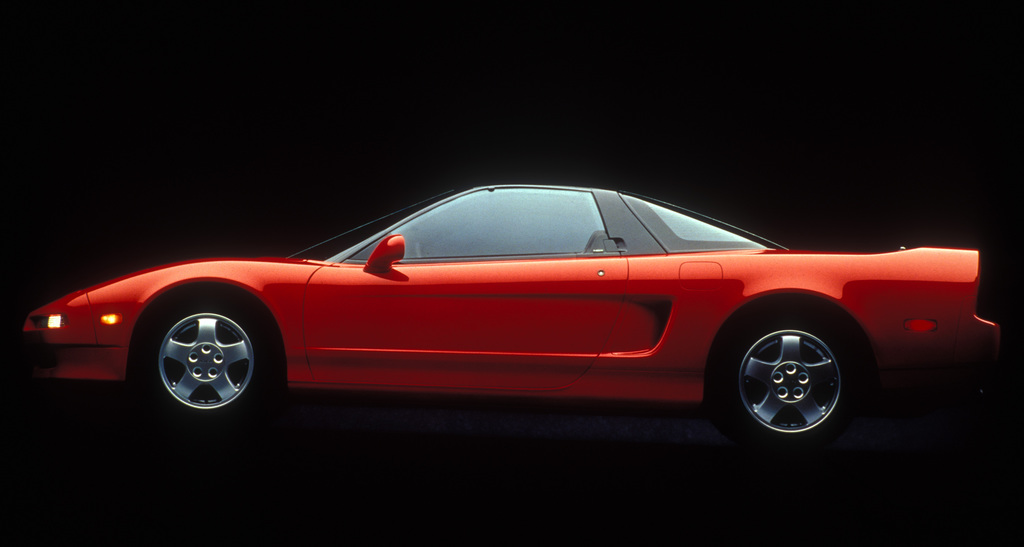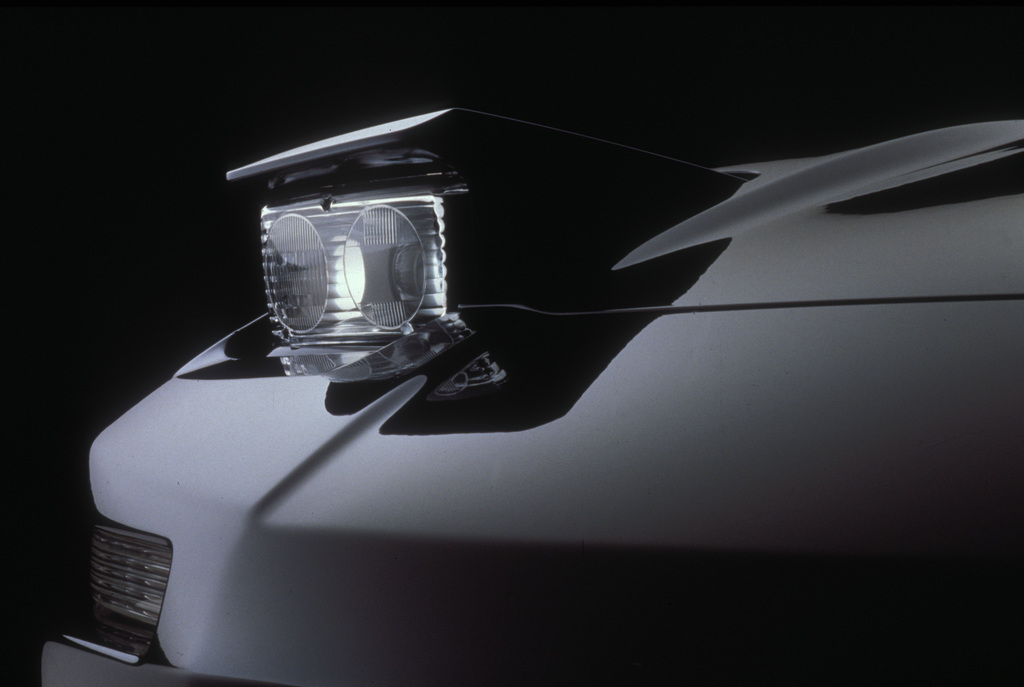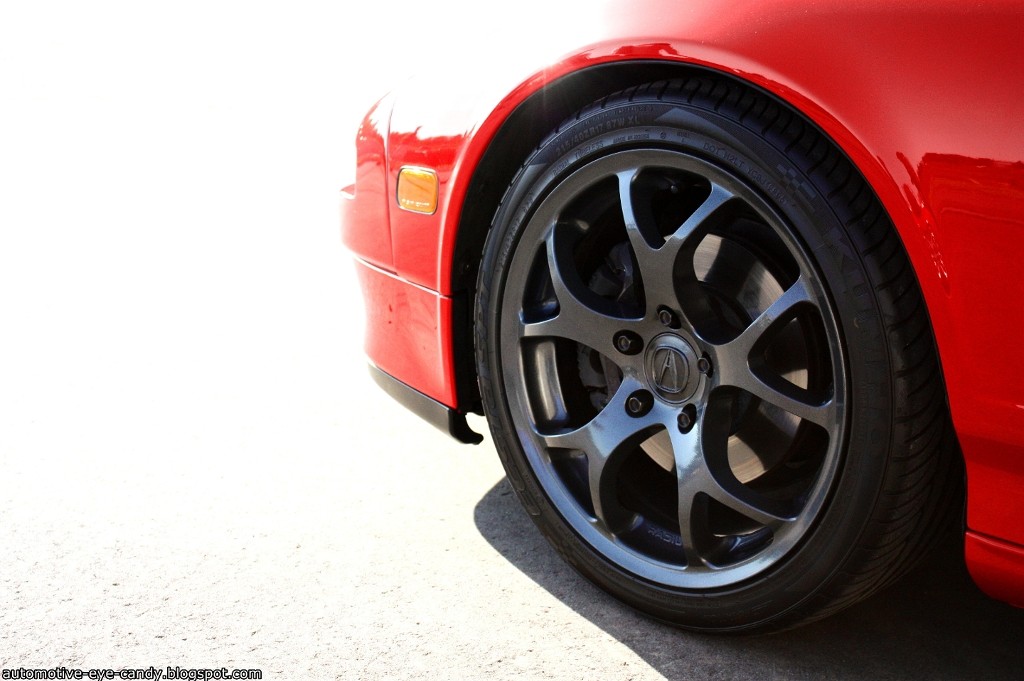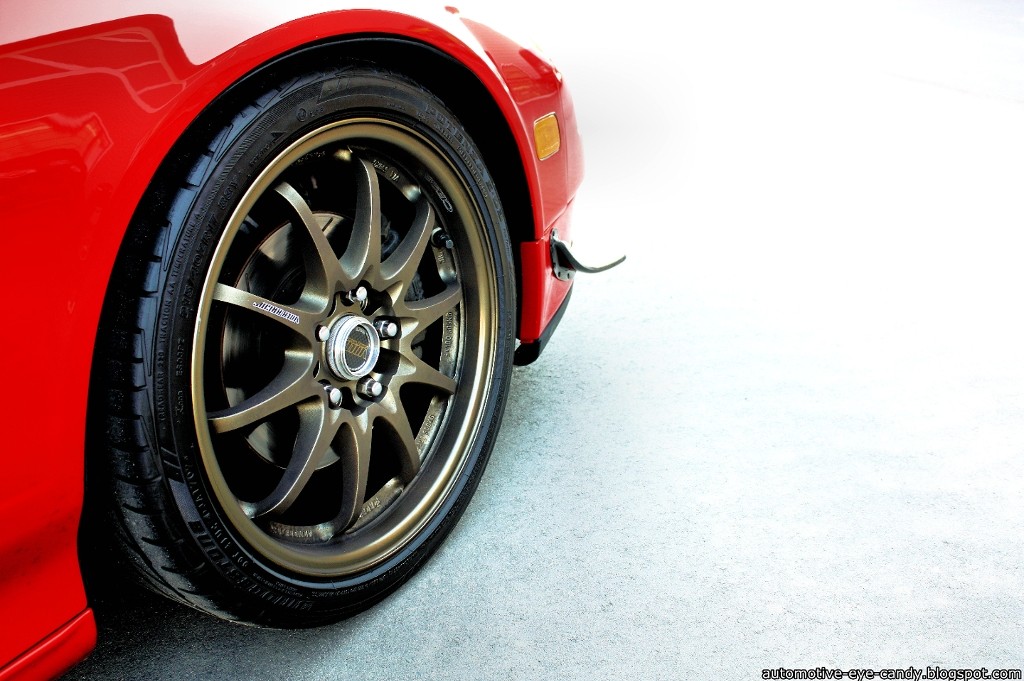1991→2002 Acura NSX
In 1991 Honda introduced the NSX to the North American market as the Acura NSX. It retained the same features as the Honda NSX including it’s all-aluminum chassis, aluminum suspension and the 3.0-liter VTEC engine with titanium connecting rods.
As a result the NSX was a serious contender to the Ferrari 348 and Porsche 911.
Press Release
Honda Research and Development engineers have long held the dream of producing a world class sports car. With the decisionto create the Acura Division, an appropriate channel became availablefor the distribution of an automobile of this caliber. This automobile would become both a rolling showcase for the firm’s technical prowess, and also establish the “performance/luxury” image the Acura Division needed to achieve if it were going to be recognized as a leader in that market segment.
The car that was to become the Acura NSX was envisioned as being not merely a competitor for the exotics and near-exotics already on the market, but a groundbreaking vehicle that would provide the emotional and visceral excitement which is part and parcel of driving an exotic car, and embody the unique Honda spirit.
To understand the how and why Honda even considered building a car like the NSX, it’s first necessary to understand the spirit and the high level of car enthusiasm that suffuses every aspect of Honda’s worldwide organization. Historically, Honda has always been a “racing” company. From its initial interest in motorcycle racing in the ’60s , to its current dominance in FormulaOne, Honda has always taken racing as a serious endeavor. And its involvement with motorsports was never an afterthought or promoted on an occasional basis as an adjunct to the latest marketing strategy. It was an integral part of Soichiro Honda’s philosophy, a philosophy that was nurtured and encouraged and placed at the core of Honda’s approach to building cars. As a result, the enthusiast ethic, the idea that cars, no matter what their market niche, should be amply endowed with a large dose of driving fun, is part of everyone’s job description. It comes with the territory.
The Honda spirit and mindset, while multi-faceted, can be encapsulated as “an intense emotional involvement with cars.” As Honda sees it, driving isn’t merely a method of achieving a destination. It should alsobe a recreational activity that frees the mind, excites the senses and provides a means for relaxation. Part of that excitement is the result of a human-oriented approach to car building, an approach which recognizes that all a car’s priorities should be devoted toward entertaining and satisfying the driver. Whether it involves the shape of a shifter knob or the shape of the torque curve, it has to make sense to the driver and make his time behind the wheel both intriguing and pleasing. That approach further recognizes that it takes much more than raw horsepower or high lateral acceleration numbers to satisfy a dedicated, knowledgeable sports car owner. What that type of driver demands above all is balanced performance.
Stated simply, the intention in creating the Acura NSX was to produce a handbuilt, exotic, mid-engine sports car that would establish entirely new levels of performance, refinement, driveability and reliability.In essence, the NSX is intended to represent an entirely new definition of the exotic sports car.
Concept and Goal
The NSX project was initiated in 1984. The engineers at Tochigi Research and Development Center created a list of attributes the future NSX had to possess. First on their list was top-rank performance on a level equal to or greater than the existing exotics. Their interpretation of performance was not narrowly defined to a few areas such as power, handling and brakillg, but included areas that are often given less attention by the traditional builders of exotica.
Crucial to this concept was liveability.The car had to be as easy to live with as any other Acura product despite the very high performance goals. That meant incorporating such attributes as excellent visibility, comfort, reliability in all components, and active and passive safety systems.The challenge they saw was integrating these concepts, which are in many cases mutually exclusive, into a midengine high performance car.
In their survey of the extant exotic and sports cars, the project leaders saw a clearly delineated map. One section contained the limited-production exotics such as Ferrari, Lamborghini, Lotus, and the more rarified versions of the venerable Porsche 911. Aside from the mid- or rear-engine configuration, this class of car is characterized by a heavy emphasis on engine power and the first priority is given to packaging the mechanical components. They are also the sort of cars that demand constant attention, both in service and maintenance and when driven quickly. Part of the cachet of these vehicles is the fact that they’re sometimes idiosyncratic, quirky and have to be mastered or coerced into submission by a very skilled driver. Their ergonomics are often far from ideal- something which can be perceived as either anachronistically charming, or just exasperating. This type of car, while great fun to drive on an occasional basis, may become tiresome when driven daily or on a long trip. Although their power to weight ratios and visceral thrills are desirable qualities, the Acura NSX would not be a car just for Sunday afternoons.
On the other end of the sports car spectrum are the lightweight, mass-produced sporty cars like Miata and MR2. While these vehicles provide a high degree of reliability and fun at an affordable price, they don’t possess the very high levels of performance the project leaders envisioned for the NSX. Their most desirable traits are light overall weight and good ergonomic packaging. They can be driven easily at moderate speed and make no unnecessary demands on the driver.
Occupying the middle ground are the middle weight mass-production cars like Corvette and 300ZX. These are certainly livable sports cars with sufficient performance to satisfy an enthusiast. Their priorities include comfort and convenience. And while they can excel in certain areas, their overall performance is compromised due to their high overall weight and abundance of luxury features. The Acura NSX was envisioned as stretching the current sports car envelope. It would occupy a segment that was philosophically much closer to the lightweight, highly responsive characteristics, of a Formula One car than either the traditional heavyweight sports cars or the middleweight sports/touring machines. It was to be a synthesis combining the light weight of a “sporty” car, the power output, looks, performance, limited production, and packaging of an exotic, and the ergonomics and livability of a middleweight sports car. Most importantly, the Acura NSX was to be a car that could be driven very, very quickly, and right to the limit without extraordinary efforts by the driver. There would be no need for the driver to accommodate himself to quirky handling characteristics, disturbing drop-throttle oversteer or any of the other negative attributes commonly associated with exotic sports cars. Oearly, this was an ambitious goal. Nothing like the NSX has been attempted before and, if successful, the NSX would redefine the meaning of an exotic.
In order to fully express the Honda spirit, the project team knew the NSX must not be a clone of an existing exotic, nor an upgraded, limited-production version of a mass-produced car. They also knew it had to have extremely high limits, fast but linear responses, light weight, packed with the latest technological advances and provide excellent reliability. But the question they asked themselves was how do you hit a target when no one has yet etched the boundaries of that target? The NSX was staking a claim on unknown territory and the real problem was figuring out how you get there from here.
To give the goal a fixed point of focus, the project team turned for inspiration to the General Dynamics F-16 Falcon. This all-weather air-superiority aircraft embodied virtually everything they envisioned for the NSX. It’s the latest iteration of the single seat dogfighter, a light weight, very responsive, highly maneuverable single engine interceptor with an awesome performance envelope and dizzying thrust to weight ratio. Clearly, the NSX wouldn’t attempt to equate itself with this fighter, but the basic principles of light weight, responsiveness and maneuverability could successfully be emulated and carried over from aircraft to sports car. With the image of the F-16 fixed in their minds, the project team began the task of setting definite weight and power targets and sketching the basic parameters of the NSX.
In order to achieve the intended performance target, they postulated that the NSX would require a power-to-weight ratio of 5.0 to 5.5 kg./hp (11.0 to 12.1lbs./hp). And to achieve the handling and response targets, the car should weigh under 30001bs. With that weight, the engine would need to produce at least 250 hp to maintain the power to weight ratio. By using engine control technology that was already in progress, it was clear that a normally aspirated V6 was the optimum engine configuration to achieve the required horsepower target, quick throttle response and free-revving capabilities. A V6 was the right size, it offered the low weight and produced enough power to achieve the intended goals.
The question of weight however wasn’t as easily addressed. A mid-engine car is inherently heavier than a front-engine car due to the large amount of structural reinforcement necessary to produce a rigid monocoque chassis. Building a steel chassis with a wheelbase long enough and a track wide enough to allow an amply sized, comfortable cockpit, adequate trunk room and a large enough engine bay, would have exceeded the 3000 lb. weight target. The engineers were unwilling to make this compromise because it would have a negative impact on the agile, responsive handling they desired. The only logical solution was to explore weight reduction techniques. Building on existing research and on a newly launched research endeavor, the team concluded that aluminum was the only material that could accomplish this goal.
Finally ,to provide the exclusivity a car of this caliber deserves, it was decided that the NSX should be built in low volumes in a new production facility dedicated exclusively to its manufacture.
Overview
The mid-engine, two-seat Acura NSX is powered by an all-aluminuml 3.0-liter V6 which produces 270hp and 210lbs.-ft. of torque. The normally aspirated engine is equipped with dual overhead cams, four valves per cylinder,Variable Valve Timing and Lift Electronic Control (VTEC), and a Variable Volume Induction System.The engine also offers Programmed Fuel Injection and a Direct Ignition System which uses an individual coil mounted atop each spark plug instead of a single coil. To help ensure high engine speed durability,specially developed titanium connecting rods are used. A five speed manual transaxle is standard with an electronically controlled 4-speed automatic available as optional equipment. Standard equipment with the automatic is a variable-assist, speed sensitive electric power rack-and-pinion steering system.
The NSX features all-aluminumunit body construction for light weight. The all independent suspension also features aluminum alloy control arms and hub carriers front and rear, and an aluminum cradle for the front and rear suspension. The braking system features four-wheel ventilated discs front and rear and an advanced 4-channel Anti-Lock Braking System. A sophisticated Traction Control System has been designed to limit wheelspin and help enhance control on slippery surfaces. The vehicle dimensions are as follows:
*Wheelbases 99.6in (2530mm)
*Track F/R 59.4in (1510mm)/ 60.2in (1530mm)
*Overall Length 173.4in (4405mm)
*Overall Width 71.3in (1810mm)
*Overall Height 46.1in (1170mm)
*Curb Weight 3010lbs(1365kg)- 5-speed
*3098lbs (1405 kg) – Automatic
An assembly plant, dedicated exclusively to the manufacture of the NSX has been built on the grounds of Honda’s Research and Development Center in Tochigi. The plant utilizes unique assembly techniques based on highly experienced assembly teams and eliminates the traditional assembly line to build a distinct, hand-crafted sports car. Production of the NSX is a maximum 25 vehicles per day. A total of 3000 cars are scheduled for delivery to the U.S. in the first full year of production.
In Detail
| type | Series Production Car |
| production years | 1991 – 2002 |
| released at | 1989 Chicago Motor Show |
| built at | Tochigi, Japan |
| price $ | $ 60,000 |
| engine | All Aluminum V6 |
| position | Transverse Mid-Engine |
| valvetrain | DOHC 4-Valves / Cyl |
| fuel feed | Honda PGM-F1 Electronic Injection |
| displacement | 2977 cc / 181.7 in³ |
| bore | 90.0 mm / 3.54 in |
| stroke | 78.0 mm / 3.07 in |
| compression | 10.2:1 |
| power | 201.3 kw / 270 bhp @ 7100 rpm |
| specific output | 90.7 bhp per litre |
| bhp/weight | 199.41 bhp per tonne |
| torque | 284.7 nm / 210.0 ft lbs @ 5300 rpm |
| redline | 8000 |
| body / frame | Unit Aluminum |
| driven wheels | Mid Engine / RWD |
| front tires | F 225/50ZR-15 |
| rear tires | R 225/50ZR-16 |
| front brakes | Vented Discs w/ABS, Vacuum Assist |
| rear brakes | Vented Discs w/ABS, Vacuum Assist |
| front wheels | F 38.1 x 16.5 cm / 15 x 6.5 in |
| rear wheels | R 40.6 x 20.3 cm / 16 x 8 in |
| steering | Rack & Pinion |
| f suspension | A-Arms w/Coil Springs, Tube Shocks, Anti Roll Bar |
| r suspension | A-Arms w/Coil Springs, Tube Shocks, Anti Roll Bar |
| curb weight | 1354 kg / 2985 lbs |
| wheelbase | 2530 mm / 99.6 in |
| front track | 1509 mm / 59.4 in |
| rear track | 1529 mm / 60.2 in |
| length | 4404 mm / 173.4 in |
| width | 1811 mm / 71.3 in |
| height | 1171 mm / 46.1 in |
| transmission | 5-Speed Manual |
| gear ratios | 3.07:1, 1.73:1, 1.23:1, 0.97:1, 0.77:1 |
| final drive | 4.06:1 |
| top speed | ~270.4 kph / 168.0 mph |
| 0 – 60 mph | ~5.6 seconds |
| 0 – 100 mph | ~14.1 seconds |
| drag | 0.32 Cd |


